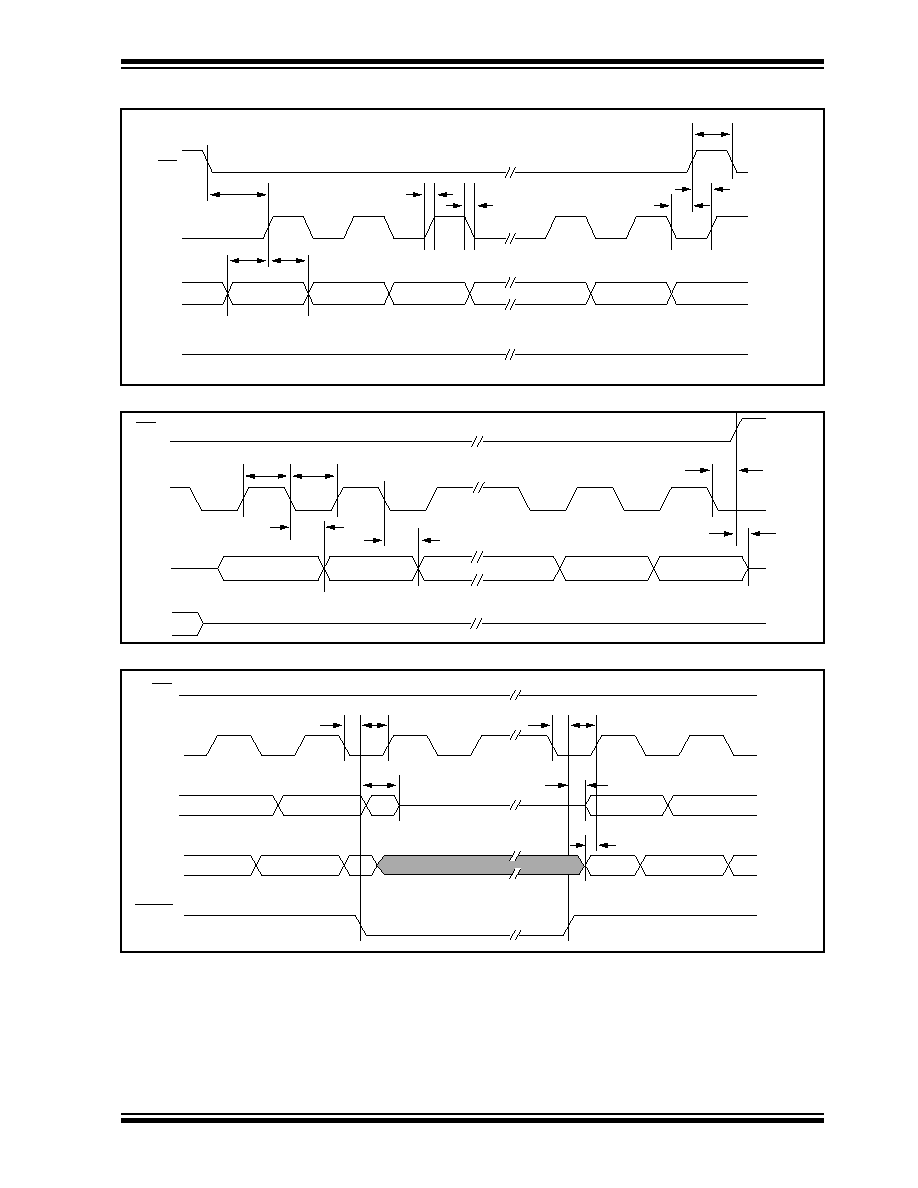 | –≠–ª–µ–∫—Ç—Ä–æ–Ω–Ω—ã–π –∫–æ–º–ø–æ–Ω–µ–Ω—Ç: 24AA160-P | –°–∫–∞—á–∞—Ç—å:  PDF PDF  ZIP ZIP |

©
1996 Microchip Technology Inc.
Preliminary
DS21146D-page 1
FEATURES
∑ 3 MHz Clock Rate
∑ SPI Modes 0,0 and 1,1.
∑ Single supply with programming operation down
to 1.8V
∑ Low Power CMOS Technology
- Max Write Current: 5 mA
- Read Current: 1.0 mA
- Standby Current: 1
µ
A typical
∑ Organization
- 1024 x 8 for 25AA080
- 2048 x 8 for 25AA160
∑ 16 Byte Page
∑ Self-timed ERASE and WRITE Cycles
∑ Sequential Read
∑ Block Write Protection
- Protect none, 1/4, 1/2, or all of Array
∑ Built-in Write Protection
- Power On/Off Data Protection Circuitry
- Write Latch
- Write Protect Pin
∑ High Reliability
- Endurance: 10M cycles (guaranteed)
- Data Retention: >200 years
- ESD protection: >4000 V
∑ 8-pin PDIP/SOIC Packages
∑ Temperature ranges supported
DESCRIPTION
The Microchip Technology Inc. 25AA080/160 are 8K
and 16K bit Serial Electrically Erasable PROMs. The
memory is accessed via a simple Serial Peripheral
Interface (SPI) compatible serial bus. The bus signals
required are a clock input (SCK) plus separate data in
(SI) and data out (SO) lines. Access to the device is
controlled through a chip select (CS) input, allowing any
number of devices to share the same bus.
There are two other inputs that provide the end user
with additional flexibility. Communication to the device
can be paused via the hold pin (HOLD). While the
device is paused, transitions on its inputs will be
ignored, with the exception of chip select, allowing the
host to service higher priority interrupts. Also write
operations to the Status Register can be disabled via
the write protect pin (WP).
- Commercial (C):
0
∞
C to
+70
∞
C
- Industrial (I):
-40
∞
C to
+85
∞
C
PACKAGE TYPES
BLOCK DIAGRAM
25AA080/16
0
25AA080/16
0
CS
SO
WP
Vss
Vcc
HOLD
SCK
SI
1
2
3
4
8
7
6
5
CS
SO
WP
Vss
Vcc
HOLD
SCK
SI
1
2
3
4
8
7
6
5
PDIP
SOIC
SI
SO
SCK
CS
HOLD
WP
Status
Register
I/O Control
Memory
Control
Logic
X
Dec
HV Generator
EEPROM
Array
Page Latches
Y Decoder
Sense Amp.
R/W Control
Logic
Vcc
Vss
25AA080/160
8K/16K 1.8V SPI
TM
Bus Serial EEPROM
SPI is a trademark of Motorola.
This document was created with FrameMaker 4 0 4

25AA080/160
DS21146D-page 2
Preliminary
©
1996 Microchip Technology Inc.
1.0
ELECTRICAL
CHARACTERISTICS
1.1
Maximum Ratings*
V
CC
....................................................................... 7.0V
All inputs and outputs w.r.t. ......V
SS
-0.6V to V
CC
+1.0V
Storage temperature .............................-65∞C to 150∞C
Ambient temperature under bias ...........-65∞C to 125∞C
Soldering temperature of leads (10 seconds) ...+300∞C
ESD protection on all pins...................................... 4kV
*
Notice:
Stresses above those listed under `Maximum ratings'
may cause permanent damage to the device. This is a stress
rating only and functional operation of the device at those or
any other conditions above those indicated in the operational
listings of this specification is not implied. Exposure to maxi-
mum rating conditions for extended period of time may affect
device reliability.
TABLE 1-1:
PIN FUNCTION TABLE
Name
Function
CS
Chip Select Input
SO
Serial Data Output
SI
Serial Data Input
SCK
Serial Clock Input
WP
Write Protect Pin
V
SS
Ground
V
CC
Supply Voltage
HOLD
Hold Input
FIGURE 1-1:
AC TEST CIRCUIT
1.2
AC Test Conditions
AC Waveform:
V
LO
= 0.2V
V
HI
= Vcc - 0.2V
(Note 1)
V
HI
= 4.0V
(Note 2)
Timing Measurement Reference Level
Input
0.5 V
CC
Output
0.5 V
CC
Note 1: For V
CC
4.0V
2: For V
CC
> 4.0V
Vcc
SO
100 pF
1.8 K
2.25 K
TABLE 1-2:
DC CHARACTERISTICS
Applicable over recommended operating ranges shown below unless otherwise noted.
V
CC
= +1.8V to 5.5V
Commercial (C): Tamb
=
0∞C to +70∞C
Industrial (I):
Tamb
=
-40
∞
C to +85
∞
C
Parameter
Symbol
Min
Max
Units
Test Conditions
High level input voltage
V
IH1
2.0
V
CC
+1
V
V
CC
2.7V
V
IH2
0.7 V
CC
V
CC
+1
V
V
CC
< 2.7V
Low level input voltage
V
IL1
-0.3
0.8
V
V
CC
2.7V
V
IL2
-0.3
0.3 V
CC
V
V
CC
< 2.7V
Low level output voltage
V
OL
--
0.4
V
I
OL
=2.1 mA
High level output voltage
V
OH
V
CC
-0.5
--
V
I
OH
=-400
µ
A
Input leakage current
I
LI
-10
10
µ
A
CS=V
IH
, V
IN
=V
SS
to V
CC
Output leakage current
I
LO
-10
10
µ
A
CS=V
IH
, V
OUT
=V
SS
to V
CC
Internal Capacitance
(all inputs and outputs)
C
INT
--
7
pF
Tamb=25∞C, F
CLK
=3.0 MHz,
V
CC
=5.5V (Note)
Operating Current
I
CC
WRITE
--
--
5
3
mA
mA
V
CC
=5.5V
V
CC
=2.5V
I
CC
READ
--
--
1
500
mA
µ
A
V
CC
=5.5V; 3 MHz
V
CC
=2.5V; 2 MHz
Standby Current
I
CCS
--
--
5
2
µ
A
µ
A
CS=V
CC
=5.5V; Vin=0V or V
CC
CS=V
CC
=2.5V; Vin=0V or V
CC
Note:
This parameter is periodically sampled and not 100% tested.

©
1996 Microchip Technology Inc.
Preliminary
DS21146D-page 3
25AA080/160
FIGURE 1-2:
SERIAL INPUT TIMING
FIGURE 1-3:
SERIAL OUTPUT TIMING
FIGURE 1-4:
HOLD TIMING
CS
SCK
SI
SO
t
CSS
t
HD
t
SU
t
F
t
R
t
CSD
t
CLD
t
CSH
LSB in
MSB in
high impedance
CS
SCK
SO
t
LO
t
HI
t
HO
t
V
MSB out
LSB out
t
CSH
t
DIS
don't care
SI
CS
SCK
SO
SI
HOLD
t
HH
t
HS
t
HS
t
HH
t
HV
t
HZ
don't care
t
SU
high impedance
n+2
n+1
n
n-1
n
n+2
n+1
n
n
n-1

25AA080/160
DS21146D-page 4
Preliminary
©
1996 Microchip Technology Inc.
TABLE 1-3:
AC CHARACTERISTICS
Applicable over recommended operating ranges shown below unless otherwise noted.
VCC = +1.8V to 5.5V
Commercial (C):
Tamb = 0∞C to +70∞C
Industrial (I):
Tamb = -40
∞
C to +85
∞
C
Symbol
Parameter
Min
Max
Units
Test Conditions
fSCK
Clock Frequency
--
--
--
3
2
1
MHz
MHz
MHz
VCC=4.5V to 5.5V
VCC=2.5V to 4.5V
VCC=1.8V to 2.5V
tCSS
CS Setup Time
100
250
500
--
--
--
ns
ns
ns
VCC=4.5V to 5.5V
VCC=2.5V to 4.5V
VCC=1.8V to 2.5V
tCSH
CS Hold Time
100
250
500
--
--
--
ns
ns
ns
VCC=4.5V to 5.5V
VCC=2.5V to 4.5V
VCC=1.8V to 2.5V
tCSD
CS Disable Time
250
500
500
--
--
--
ns
ns
ns
VCC=4.5V to 5.5V
VCC=2.5V to 4.5V
VCC=1.8V to 2.5V
tSU
Data Setup Time
30
50
50
--
--
--
ns
ns
ns
VCC=4.5V to 5.5V
VCC=2.5V to 4.5V
VCC=1.8V to 2.5V
tHD
Data Hold Time
50
100
100
--
--
--
ns
ns
ns
VCC=4.5V to 5.5V
VCC=2.5V to 4.5V
VCC=1.8V to 2.5V
tR
CLK Rise Time
--
2
µ
s
(Note 1)
tF
CLK Fall Time
--
2
µ
s
(Note 1)
tHI
Clock High Time
150
250
475
--
--
--
ns
ns
ns
VCC=4.5V to 5.5V
VCC=2.5V to 4.5V
VCC=1.8V to 2.5V
tLO
Clock Low Time
150
250
475
--
--
--
ns
ns
ns
VCC=4.5V to 5.5V
VCC=2.5V to 4.5V
VCC=1.8V to 2.5V
tCLD
Clock Delay Time
50
--
ns
tV
Output Valid from
Clock Low
--
--
--
150
250
475
ns
ns
ns
VCC=4.5V to 5.5V
VCC=2.5V to 4.5V
VCC=1.8V to 2.5V
tHO
Output Hold Time
0
--
ns
tDIS
Output Disable Time
--
--
--
200
250
500
ns
ns
ns
VCC=4.5V to 5.5V (Note 1)
VCC=2.5V to 4.5V (Note 1)
VCC=1.8V to 2.5V (Note 1)
tHS
HOLD Setup Time
100
100
200
--
--
--
ns
ns
ns
VCC=4.5V to 5.5V
VCC=2.5V to 4.5V
VCC=1.8V to 2.5V
tHH
HOLD Hold Time
100
100
200
--
--
--
ns
ns
ns
VCC=4.5V to 5.5V
VCC=2.5V to 4.5V
VCC=1.8V to 2.5V
tHZ
HOLD Low to Output High-Z
100
150
200
--
--
--
ns
ns
ns
VCC=4.5V to 5.5V (Note 1)
VCC=2.5V to 4.5V (Note 1)
VCC=1.8V to 2.5V (Note 1)
tHV
HOLD High to Output Valid
100
150
200
--
--
--
ns
ns
ns
VCC=4.5V to 5.5V (Note 1)
VCC=2.5V to 4.5V (Note 1)
VCC=1.8V to 2.5V (Note 1)
tWC
Internal Write Cycle Time
--
5
ms
(Note 2)
--
Endurance
10M
--
E/W
Cycles
25
∞
C, Vcc = 5.0V, Block Mode (Note 3)
Note 1:
This parameter is periodically sampled and not 100% tested.
2:
twc begins on the rising edge of CS after a valid write sequence and ends when the internal self-timed write cycle is com-
plete.
3:
This parameter is not tested but guaranteed by characterization. For endurance estimates in a specific application, please
consult the Total Endurance Model which can be obtained on our BBS or website.
This document was created with FrameMaker 4 0 4

©
1996 Microchip Technology Inc.
Preliminary
DS21146D-page 5
25AA080/160
2.0
PRINCIPLES OF OPERATION
The 25AA080/160 is an 1024/2048 byte EEPROM
designed to interface directly with the Serial Peripheral
Interface (SPI) port of many of today's popular micro-
controller families, including Microchip's midrange
PIC16CXX microcontrollers. It may also interface with
microcontrollers that do not have a built-in SPI port by
using discrete I/O lines programmed properly with soft-
ware.
The 25AA080/160 contains an 8-bit instruction register.
The part is accessed via the SI pin, with data being
clocked in on the rising edge of SCK. If the WPEN bit in
the status register is set, the WP pin must be held high
to allow writing to the non-volatile bits in the status reg-
ister.
Table 2-1 contains a list of the possible instruction bytes
and format for device operation. All instructions,
addresses and data are transferred MSB first, LSB last.
Data is sampled on the first rising edge of SCK after CS
goes low. If the clock line is shared with other peripheral
devices on the SPI bus, the user can assert the HOLD
input and place the 25AA080/160 in `HOLD' mode.
After releasing the HOLD pin, operation will resume
from the point when the HOLD was asserted.
2.1
Write Enable (WREN) and Write
Disable (WRDI)
The 25AA080/160 contains a write enable latch. This
latch must be set before any write operation will be
completed internally. The WREN instruction will set the
latch, and the WRDI will reset the latch. The following is
a list of conditions under which the write enable latch
will be reset:
∑ Power-up
∑ WRDI instruction successfully executed
∑ WRSR instruction successfully executed
∑ WRITE instruction successfully executed
2.2
Read Status Register (RDSR)
The RDSR instruction provides access to the status
register. The status register may be read at any time,
even during a write cycle. The status register is format-
ted as follows:
The Write-In-Process (WIP) bit indicates whether the
25AA080/160 is busy with a write operation. When set
to a `1' a write is in progress, when set to a `0' no write
is in progress. This bit is read only.
The Write Enable Latch (WEL) bit indicates the status
of the write enable latch. When set to a `1' the latch
allows writes to the array and status register, when set
to a `0' the latch prohibits writes to the array and status
register. The state of this bit can always be updated via
the WREN or WRDI commands regardless of the state
of write protection on the status register. This bit is read
only.
The Block Protection (BP0 and BP1) bits indicate
which blocks are currently write protected. These bits
are set by the user issuing the WRSR instruction.
These bits are non-volatile.
The Write Protect Enable (WPEN) bit is a non-volatile
bit that is available as an enable bit for the WP pin. The
Write Protect (WP) pin and the Write Protect Enable
(WPEN) bit in the status register control the program-
mable hardware write protect feature. Hardware write
protection is enabled when WP pin is low and the
WPEN bit is high. Hardware write protection is disabled
when either the WP pin is high or the WPEN bit is low.
When the chip is hardware write protected, only writes
to non-volatile bits in the status register are disabled.
See Table 2-2 for matrix of functionality on the WPEN
bit and Figure 2-1 for a flowchart of Table 2-2.
See Figure 3-5 for RDSR timing sequence.
7
6
5
4
3
2
1
0
WPEN
X
X
X
BP1
BP0
WEL
WIP




